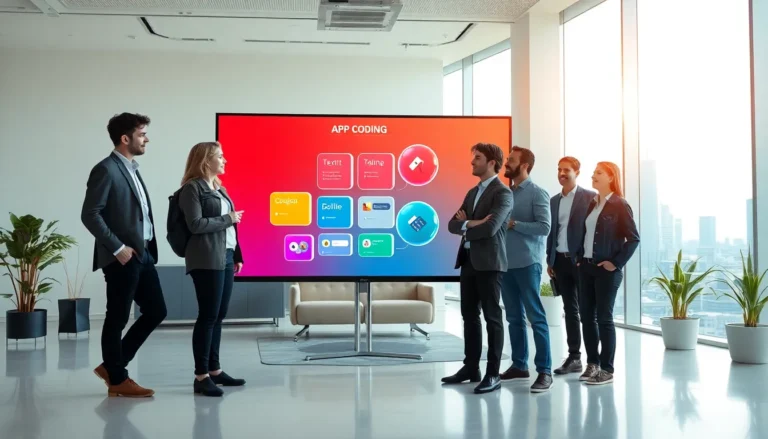In today’s digital age, the ability to create apps without coding has transformed the way entrepreneurs and businesses approach app development. No longer confined to those with technical expertise, app creation is now accessible to anyone with a vision. This shift empowers individuals to bring their ideas to life, fostering innovation and creativity.
With user-friendly platforms and intuitive tools, anyone can design functional apps tailored to their needs. Whether it’s a simple personal project or a complex business solution, the options are limitless. As the demand for mobile applications continues to rise, understanding how to create apps without coding can open doors to new opportunities and streamline processes in various industries.
Table of Contents
ToggleOverview of No-Code App Development
No-code app development enables users to design and build applications without writing code. It leverages intuitive visual interfaces and drag-and-drop functionalities. Individuals can create complex software across various platforms, significantly reducing development time and costs.
No-code platforms cater to a wide range of users, from entrepreneurs to large enterprises. They offer templates and pre-built components that streamline the development process. Users can customize these elements to fit specific needs, fostering creativity and innovation.
Key features of no-code development include:
- User-Friendly Interfaces: Simplified design processes that require minimal training.
- Rapid Prototyping: Quick iterations allow for immediate feedback and adjustments.
- Integration Capabilities: Seamless connections with existing tools and services enhance app functionality.
- Cost Efficiency: Lower expenses associated with hiring specialized developers.
Growing demand for mobile applications drives the rise of no-code solutions. Businesses can rapidly respond to market changes, adapting or creating apps to suit evolving customer needs. No-code development not only democratizes software creation but also promotes collaboration among teams, allowing for diverse viewpoints in the development process.
Benefits of Creating Apps Without Coding

Creating apps without coding presents several advantages, particularly in enhancing accessibility and accelerating development. These benefits support businesses and individuals in effectively utilizing resources and time.
Accessibility for Non-Developers
No-code platforms cater to individuals lacking programming knowledge. They provide user-friendly interfaces, enabling users to design applications intuitively. Many tools incorporate drag-and-drop functionalities, removing technical barriers to entry. Startups, small businesses, and hobbyists can leverage no-code solutions to transform ideas into functional apps without needing a dedicated development team. This democratization of app creation fosters inclusivity across various sectors.
Speed of Development
No-code development significantly reduces the time required to build applications. Traditional coding can take weeks or months, while no-code tools facilitate rapid prototyping, allowing users to bring their concepts to life in days. Quick iterations enable real-time feedback and seamless adjustments, allowing users to respond swiftly to changing market demands. Businesses can launch applications faster, gaining a competitive edge in their respective industries.
Popular No-Code Platforms
Numerous no-code platforms empower users to create applications efficiently and effectively. Each platform offers unique features and is tailored to specific use cases, catering to varying user needs and preferences.
Features Comparison
| Platform | Visual Interface | Integration Capabilities | Pricing Model | Target Audience |
|---|---|---|---|---|
| Bubble | Yes | Extensive | Tiered Subscription | Entrepreneurs, Startups |
| Adalo | Yes | Medium | Pay As You Go | Small Businesses, Individuals |
| Appgyver | Yes | Advanced | Free & Paid Options | Enterprises, Developers |
| Webflow | Yes | Limited | Tiered Subscription | Designers, Freelancers |
| Glitch | Yes | Basic | Free | Hobbyists, Developers |
Use Cases of Each Platform
- Bubble: Ideal for complex web applications, including social networks and marketplaces, allowing extensive customization and functionality without coding.
- Adalo: Suitable for building mobile applications, particularly in industries like health and fitness, offering pre-built components to streamline app creation.
- Appgyver: Designed for large enterprises needing sophisticated applications, accommodating data management and robust logic without writing code.
- Webflow: Focused on web design, enabling designers to create responsive websites while handling interactions and animations easily.
- Glitch: Enables fast prototyping and collaborative projects, often used by hobbyists and developers for building simple apps or experimenting with ideas.
Step-by-Step Guide to Creating Apps Without Coding
Creating apps without coding involves several straightforward steps. This guide outlines the essential phases for transforming ideas into functional applications using no-code platforms.
Idea Validation
Validating an app idea is crucial before proceeding. Conduct market research to identify target users and analyze competitors. Gather feedback through surveys or interviews to understand user needs. Assess the feasibility of the idea based on potential demand. Compile data to refine the concept.
Choosing the Right Platform
Selecting an appropriate no-code platform can influence the app’s success. Evaluate platforms based on specific criteria such as:
- Features: Assess the tools for design, functionality, and integration.
- User Experience: Prioritize platforms with intuitive interfaces for easy navigation.
- Pricing: Compare subscription models, paying attention to budget constraints.
- Support: Look for platforms that offer robust customer support and educational resources.
Designing the App
Designing the app involves creating a user-friendly interface. Utilize templates and drag-and-drop builders to arrange elements effectively. Focus on key aspects such as:
- Layout: Design with a clear visual hierarchy to enhance usability.
- Branding: Incorporate consistent colors, fonts, and logos to establish identity.
- Accessibility: Ensure the design is accessible to all users, including those with disabilities.
Testing and Launching
Testing ensures the app functions as intended. Conduct thorough testing to identify bugs or user experience issues. Use methods like:
- Beta Testing: Invite a select group of users to test the app and provide feedback.
- Usability Testing: Observe real users interacting with the app to identify pain points.
After resolving issues, prepare for launch by creating marketing materials. Promote the app through social media, email campaigns, and app stores. Monitor performance metrics post-launch to make necessary adjustments.
Best Practices for No-Code App Development
No-code app development thrives on best practices that enhance the creation process. Following these guidelines ensures optimized workflows and successful applications.
- Define Your Objectives: Clarifying goals provides direction. Identifying the target audience and specific needs ensures the app addresses user demands effectively.
- Choose the Right Platform: Selecting a no-code platform aligns with project requirements. Evaluating features, scalability, and user experience helps match business needs to platform capabilities.
- Focus on User Experience (UX): Prioritizing user experience creates intuitive interfaces. Testing design elements and navigation early fosters a seamless interaction between users and the app.
- Utilize Templates and Components: Leveraging pre-built templates and components accelerates development. Customizing existing designs saves time while ensuring unique branding.
- Iterate Based on Feedback: Implementing a feedback loop encourages continual improvement. Gathering insights from users helps identify pain points and enhances the app’s functionality.
- Integrate with Existing Tools: Ensuring compatibility with existing tools streamlines operations. Seamless integrations enhance user experience by allowing data sharing and workflow automation.
- Test Thoroughly Before Launch: Conducting comprehensive tests identifies bugs and usability issues. Testing across different devices and environments ensures the app operates smoothly under various conditions.
- Plan for Scalability: Designing with future growth in mind maintains app relevance. Building a scalable architecture accommodates increasing users and features without compromising performance.
- Establish a Clear Maintenance Strategy: Implementing a maintenance plan facilitates ongoing support. Regular updates and monitoring improve app performance and user engagement over time.
No-code app development has revolutionized how individuals and businesses approach app creation. By eliminating the need for coding skills it’s opened doors for many to turn their ideas into reality. This accessibility not only fosters innovation but also accelerates the development process allowing users to respond quickly to market demands.
With a variety of platforms available each tailored to specific needs users can easily find the right tools to bring their visions to life. Embracing no-code solutions empowers creators to focus on user experience and functionality while minimizing costs and time. As the digital landscape continues to evolve the importance of no-code development will only grow making it an essential skill for aspiring entrepreneurs and established businesses alike.










